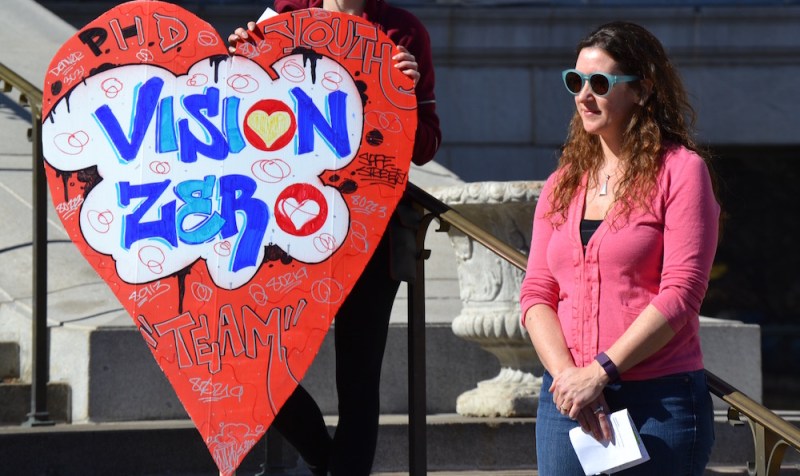WalkDenver Names Jill Locantore Executive Director

WalkDenver, Denver’s biggest pedestrian advocacy organization, has named Jill Locantore executive director.
With four years of experience at WalkDenver under her belt, Locantore replaces founder Gosia Kung, who stepped down at the end of last year.
I sat down with Locantore last week to talk about her strategy for WalkDenver and what it will be advocating for. The Hancock administration has laid out a promising agenda to improve walkability, promising to end traffic deaths by 2030, initiating a sidewalk repair program, and securing hundreds of millions of dollars for projects to make city streets safer and more multi-modal. The question is whether City Hall will deliver.
Here’s what Locantore had to say about the state of walkability in Denver and where the city goes from here. (The text represents her words — headings are mine.)
Ensuring money gets spent in the right places
Two years ago the city didn’t even want to talk about sidewalks. It wasn’t part of their vocabulary. They didn’t see it as part of their responsibility. Now everybody’s talking about sidewalks — we’ve got $50 million for sidewalks in the bond! That’s huge. But the ultimate need is a billion dollars.
So the challenge for WalkDenver is how do we leverage that win and continue the momentum towards the ultimate prize. We don’t want to let the city rest on its laurels with the GO Bond or the Vision Zero action plan.
All that money in the GO Bond, the city no longer has the excuse of saying we don’t have funding for bike and pedestrian infrastructure, but we need to make sure it’s well spent, and that it’s spent in a timely manner. We are gonna be working to get ourselves and our allies on stakeholder committees for all of these big projects that are funded in the bond to make sure that the city lives up to what they were promising.
Making Vision Zero more than a slogan
With Vision Zero, we think the city has adopted a very strong action plan. Now we need to keep the pressure on for the city to actually implement it. Both the city and the Vision Zero Coalition are focused on Federal Boulevard as one of the most important corridors out of the gate. It has 20 times the fatality rate of the average urban street in Colorado.
Our advocacy target is the city, because ultimately the street is in the city of Denver. They have [an agreement] with CDOT about how it’s managed, but the city has the power to work with CDOT on the changes. So I place the ultimate responsibility on the city to demand it.
More generally, aside from Federal Boulevard, we’re really focusing on the major arterials in Denver because that’s where the high injury network is, but that’s also where the proposed high frequency transit corridors are. If we’re ever truly going to be a walkable, bikeable, transit-friendly city, we have to do something about those streets.
The growth of streets and transportation advocacy in Denver
I think one of the exciting things about where WalkDenver is right now is that the advocacy community has matured so much that we now have all these partners — Bike Denver, Bicycle Colorado, the other members of the Denver Streets Partnership — and now I have all these other brains in these other advocacy groups that I’m regularly consulting with and working to coordinate my advocacy work with.
They were around before, but over the last couple years we’ve just started actually being coordinated in our advocacy so that we can develop shared platforms and shared asks of the city. And I think the past couple years has shown the tremendous value of that.


